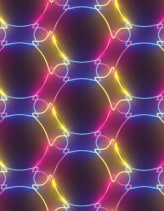Weyl loops link up
12 Jul 2022 Isabelle Dumé
The quantum electronic link in momentum (velocity) space observed in the topological Weyl magnet Co2MnGa. (Courtesy: Ilya Belopolski and M Zahid Hasan, Princeton University)
For the first time, a team of physicists have observed quantum mechanical structures known as Weyl loops linking up to form chains. These structures, which are formed from quantum states of electrons in crystalline cobalt manganese gallium (Co2MnGa), have a novel topology and must be described using knot theory. According to the team, this same theory could help explain other quantum behaviours, with possible applications including topological conductors, superconductors and even quantum bits.
Topology is a branch of mathematics in which two objects are treated as equivalent if they can be continuously deformed into one another by bending, twisting, stretching or shrinking (but not tearing or cutting). In this framework, a circle is topologically equivalent to an ellipse, and a doughnut is equivalent to a coffee mug, since the objects in both pairs can be deformed into each other by stretching.
Topology also exists on the quantum scale, and physicists led by M Zahid Hasan of Princeton University in the US have been studying topological phenomena related to shape of the electron’s wave function. These studies brought them to Weyl loops, which are structures involving Weyl fermions – massless particles first predicted in 1929 by the theoretical physicist Herman Weyl as a solution to the Dirac equation.
Mathematical linking numbers
In 2019, Hasan and colleagues observed Weyl loops in Co2MnGa, demonstrating that the material behaved anomalously in the presence of applied electric and magnetic fields. They also discovered that this anomalous behaviour persisted up to room temperature.
In the latest study, which is published in Nature, the team used soft X-ray angle-resolved photoemission spectroscopy to find that the topology of Weyl loops in Co2MnGa differs from the wavefunction winding predicted by conventional topological theories. Specifically, the quantum state consists of linked loops, which were previously little discussed in the study of topological quantum matter. Furthermore, the team observed that the linked Weyl loops adopted a configuration wherein the traditional mathematical linking number, known as the algebraic linking number, is paradoxically equal to zero.
“To resolve this puzzle, we decided to dig deep into mathematical topology and found a lesser-known linking number, the so-called geometric linking number, which describes our linked Weyl loops in Co2MnGa,” Hasan explains.
By analysing the experimental data using this geometric linking number, the team discovered that materials such as Co2MnGa can in fact host multiple Weyl loops that link up and knot in different ways – including one that Hasan describes as “a counterintuitive object folded in on itself and wrapped across a higher-dimensional torus”.
“We came to realize that some aspects of knot theory are very powerful in explaining quantum properties of topological materials that were not understood before,” he says. “This is the first example that we know of where knot theory has been applied to understand the behaviour of topological magnets.”
Could other crystals host linked Weyl loops?
Hasan adds that the new observations and analyses raise several questions. For example, are crystals other than Co2MnGa capable of hosting linked Weyl loops? “Intuition suggests that there should be many such materials awaiting discovery,” team member Ilya Belopolski tells Physics World. The team would especially like to find materials with non-zero algebraic linking numbers, Belopolski says, adding that the results also raise theoretical questions about whether the non-zero geometric linking numbers in Co2MnGa could give rise to quantized optical effects.READ MORE

Together with researchers led by Claudia Felser at the Max Planck Institute for Chemical Physics of Solids in Germany, who synthesized the Co2MnGa crystals, the team is now looking for ways to unlink and relink the Weyl loops using magnetic fields. According to Belopolski, such a method could offer a new path to studying phenomena such as the braiding of so-called Majorana fermions.
“Non-Abelian physics, such as the braiding of Majorana fermions, represents a longstanding challenge for physicists and is typically thought to require the interplay of subtle phases of matter such as superconductivity and the quantum Hall effect,” he explains. “Manipulation of linked Weyl loops in the electronic structure of a crystal may provide an alternate, simpler route to non-Abelian braiding. This is somewhat of a long-term project, but it is not impossible.”

Isabelle Dumé is a contributing editor to Physics World.
from physivsworld.com 10/8/2022

Δεν υπάρχουν σχόλια:
Δημοσίευση σχολίου